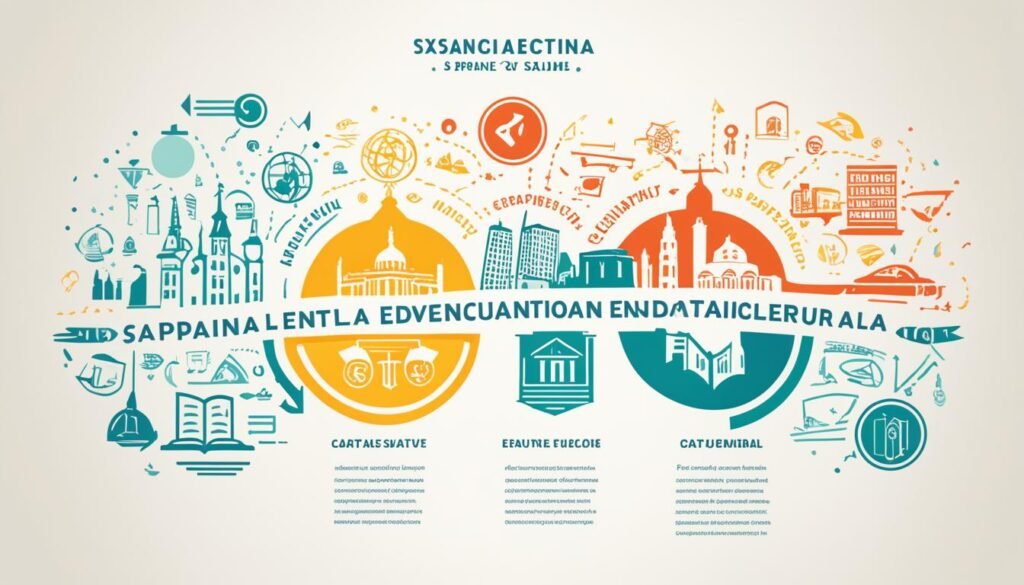The journey of Hispanic students in higher education is multifaceted, marked by the richness of their cultural heritage. Navigating this path involves overcoming unique challenges and embracing opportunities. Insights into these experiences illuminate the importance of fostering inclusive and empowering academic landscapes.
Key Takeaways:
- Understanding Spanish perspectives is crucial for creating inclusive educational environments.
- Education is highly valued within the Hispanic community, particularly among immigrants in the United States.
- Hispanic students face challenges such as language barriers and unequal access to resources in higher education.
- Cultural pride enhances the educational experience of Hispanic students.
- Nurturing cultural pride and providing family and community support are essential for Hispanic students’ success.
The Importance of Education for Hispanic Immigrants in the United States
Hispanic immigrants journey to the United States, fueled by aspirations of enhanced living standards and educational prospects for their offspring. Within this demographic, education is not merely regarded but esteemed as the conduit to prosperity, offering a means to surmount socioeconomic impediments.
This quest for education is not solely an individual endeavor but a collective ambition reflective of their communal aspirations. It’s acknowledged as the cornerstone for advancing within the intricacies of American society, equipping them with essential capabilities and knowledge.
Encountering distinctive hurdles, such as linguistic obstacles, unfamiliarity with the U.S. educational framework, and socioeconomic disparities, Hispanic immigrants display remarkable resilience. Their determination to surmount these challenges exemplifies their commitment to securing a more promising future for their kin.
Education is the key that unlocks the doors to opportunity and empowers Hispanic immigrants to build a better future for themselves and their families.
The impact of education extends beyond personal enrichment, fostering communal fortitude. Through education, Hispanic immigrants not only enhance their own lives but also contribute significantly to societal progress, championing transformative changes and elevating those within their ambit.
Educational pursuits also facilitate the melding of cultures, enabling Hispanic immigrants to honor their ancestral legacies while seamlessly integrating into American societal fabrics. This educational journey engenders a profound connection with their heritage, instilling cultural pride amidst the assimilative process.
Viewing the United States as a realm of untapped potential, Hispanic immigrants place unwavering faith in education as the linchpin to unlocking these possibilities. Their conviction steers them through obstacles, allowing them to actualize their aspirations and bequeath a legacy of triumph for progenitors.
Furthermore, the narrative shifts towards the educational adversities confronted by Hispanic students within tertiary institutions. Delving into these challenges illuminates the crucial need for supportive measures to bolster their academic endeavors.
Challenges Faced by Hispanic Students in Higher Education
Hispanic students embarking on higher education face multifaceted obstacles, impeding their pursuit of academic success. These barriers originate from various domains, notably linguistic hurdles, socio-economic status, and a paucity of accessible resources.
One poignant challenge lies in surmounting linguistic barriers. Numerous students, straddling the divide between bilingualism and English language learning, wrestle with comprehension and engagement in academic discourse. The scarcity of supportive English language resources further compounds this challenge, hampering their academic interaction.
“Language barriers introduce a multifaceted layer of difficulty for Hispanic students, thereby influencing their self-assurance and educational outcomes,” asserts Dr. Juanita Hernandez, an educational specialist ardently advocating for Hispanic students.
Furthermore, socio-economic disparities profoundly affect Hispanic scholars in academia. The economic constraints faced by many Hispanic families render the costs associated with higher education—tuition, textbooks, and sundry fees—prohibitively expensive. Consequently, students are often compelled to undertake extensive employment, adversely affecting their academic focus and engagement.
Limited resource access significantly obstructs Hispanic students’ educational trajectories. Disparities in access to eminent educational establishments, accelerated coursework, and collegiate advisory services undermine their preparatory endeavors and prospects in higher education, thus widening the academic achievement chasm within this demographic.
To mitigate these barriers, the introduction of targeted strategies and support systems is imperative. Enhancements in language support initiatives, alongside the provision of financial aid, scholarships, and augmented resources for Hispanic students, are pivotal in ensuring equitable opportunities and success in their academic endeavors.
Effective Strategies to Support Hispanic Students in Higher Education:
- Establish language support programs that cater to bilingual students and English language learners.
- Create financial aid programs and scholarships specifically designed for Hispanic students.
- Offer mentorship programs and academic guidance tailored to the unique needs of Hispanic students.
- Provide culturally relevant curriculum and resources that reflect the experiences and contributions of Hispanic communities.
- Collaborate with community organizations and stakeholders to develop partnerships that can provide additional support and resources.

By recognizing and confronting these challenges, we can engineer an inclusive, equitable academic milieu, thereby empowering Hispanic students to excel. Collaboratively, we can construct a pathway for Hispanic students to fulfill their educational aspirations, contributing significantly to societal progress.
The Importance of Cultural Pride in Hispanic Higher Education
Embracing your cultural heritage transcends mere celebration; it serves as a formidable instrument for achievement within higher educational pursuits. Cultural pride significantly influences one’s identity, instilling a sense of belonging and bolstering confidence to traverse the complexities of higher academia.
Valuing and recognizing your cultural roots within an educational framework permits access to resilience and strength. It engenders a profound comprehension of history, traditions, and values. This foundation renders you capable of surmounting obstacles and attaining unprecedented achievements.
One paramount advantage of cultural pride in Hispanic higher education lies in the enrichment of the educational experience. Acknowledging your identity introduces diverse perspectives and enhances academic discussions and collaborations. Thus, your cultural heritage emerges as an invaluable asset, enabling a deeper learning perspective and enriching both your education and that of your peers.
Cultural pride acts as a propellant for motivation and determination. A sense of pride in one’s heritage and communal accomplishments bestows a responsibility to excel. The ambition to honor forebearers’ sacrifices motivates you towards academic success and the aspiration for a superior future for oneself and others.
“Cultural pride is a catalyst for academic excellence and personal growth. It empowers Hispanic students to overcome obstacles, embrace their uniqueness, and make lasting contributions in higher education.”
Educational institutions play a vital role in promoting cultural pride among Hispanic students. By acknowledging and cherishing the diversity of their student body, these establishments can engender inclusive atmospheres that validate and celebrate every student’s cultural identity. Integration of Hispanic history, literature, and arts into the curriculum, along with cultural events and initiatives, offers Hispanic students avenues to display their heritage and develop intense pride in their identity.
Engaging with one’s cultural pride fosters a sense of community amongst students pursuing higher education. Establishing mentorship networks, seeking advice from cultural groups, and identifying role models in desired fields offers essential support. This guidance aids in navigating potential challenges encountered along the educational journey.
Your cultural heritage is not merely a differentiator but also a linkage to a substantial legacy. By embracing your cultural pride, you pave your path in higher education, overcoming hindrances and impacting future generations positively.
Nurturing Cultural Pride in Educational Institutions
Educational bodies play a pivotal role in cultivating cultural pride among Hispanic learners. They do so by integrating Hispanic heritage and achievements within their curricula, thereby enabling students to celebrate their cultural identity and foster a profound sense of community belonging.
Highlighting the accomplishments of notable Hispanic personalities such as Cesar Chavez, Dolores Huerta, and Supreme Court Justice Sonia Sotomayor, schools underscore the invaluable contributions Hispanic individuals have made across history. This recognition of Hispanic exemplars serves as a beacon of inspiration for students, driving them to aspire towards achieving their ambitions and positively influencing their communities.
Moreover, the initiation of cultural events and the celebration of Hispanic heritage months offer students platforms to exhibit their traditional customs, music, and artistry. These endeavors not only champion cultural admiration amongst the student body but also enhance inclusivity, propelling a more profound comprehension of diverse cultural narratives and experiences.

Nurturing cultural pride through language programs
At the core of cultural identity lies language, with educational institutions bolstering cultural pride through expansive language programs. Offering Spanish classes, schools acknowledge the significance of linguistic preservation, thus fortifying students’ connections to their cultural roots.
Such programs extend beyond mere linguistic proficiency, fostering intercultural comprehension and communication. Encouraging bilingual capabilities enables Hispanic students to proudly carry forward their cultural legacy while engaging with a broader societal panorama.
Creating inclusive spaces for cultural expression
Establishing inclusive environments within educational settings is paramount for the cultivation of cultural pride. Schools set the stage for this by making provisions for Hispanic student organizations and clubs, thus facilitating a venue for students to articulate their cultural identities and share their traditions.
Moreover, incentivizing educators to participate in cultural competency training augments their insight into Hispanic cultures. This initiative could include weaving Hispanic perspectives into classroom discourse and assignments, thus mirroring students’ cultural narratives within the academic fabric.
Embracing cultural diversity
It is essential for educational institutions to recognize and celebrate the multiplicity existing within the Hispanic community. By acknowledging the varied cultural facets and preferences among Hispanic students, schools can tailor educational experiences to meet their distinct needs and backgrounds.
Engaging in cultural sensitivity training and diversifying faculty ranks, educational institutions can carve spaces that respect various Hispanic cultures. Such efforts construct supportive foundations that nurture academic excellence, personal development, and cultural pride among students.
When the cultivation of cultural pride is a forefront goal, educational institutions empower Hispanic students to affirm their identities, succeed scholastically, and contribute substantially to society. In forging an ambience of inclusiveness and cultural exultation, these bodies pave the way for a fortified and vibrant educational realm for all participants.
The Role of Family and Community in Supporting Hispanic Students
In the quest for academic excellence within higher education, Hispanic students find indispensable support through their family ties, communal bonds, and rich cultural heritage. This intricate web of encouragement and guidance fundamentally enhances their educational journey. It emboldens them to confront and surmount the manifold challenges that may arise.
The imperative of parental engagement cannot be overstated in crafting a robust support framework for Hispanic scholars. Studies elucidate that students benefitting from parental involvement exhibit superior academic performance, consistent school attendance, and enhanced social prowess. Parents play a pivotal role by assisting in demystifying the complexities of college applications, elucidating the nuances of financial aid, and providing sustained emotional backing.
The contribution of mentorship schemes in bolstering Hispanic students is equally critical. Establishing connections with mentors who mirror their cultural identity or who have adeptly maneuvered through the academia labyrinth fosters invaluable guidance and motivation. Through academic counsel, career strategy, and being exemplary figures, mentors aid students in navigating obstacles towards attaining their academic and professional objectives.
Family ties, cultural heritage, and support from the wider community constitute the bedrock of empowerment for Hispanic students embarking on their educational pursuits. A collaborative effort in fortifying these support systems propels these students towards thriving in higher academia and beyond.
Targeted Strategies to Address Educational Disparities
To effectively bridge the educational achievement gap, targeted strategies aimed at eradicating disparities are critical. These measures encompass a wide range of initiatives, including comprehensive language support programs, the provision of scholarships, and the adoption of culturally relevant curricula. Together, they forge an inclusive and equitable academic landscape.
The cornerstone of providing equitable educational opportunities lies in the establishment of robust language support mechanisms. By channeling resources into programs that offer language assistance—like ESL courses and bilingual education—students are equipped to surmount linguistic hurdles, thus fostering a comprehensive engagement with their studies.
Scholarships serve as a vital instrument in enhancing higher education accessibility for students emanating from underprivileged backgrounds. Through financial aid, the economic impediments to education are mitigated, enabling students who are otherwise financially constrained to pursue their scholarly goals.
“Efforts to address educational disparities must transcend mere financial aid. It is incumbent upon us to ensure the curriculum is a reflection of the diverse tapestry of cultures and backgrounds represented by our students, to engender a truly inclusive and empowering learning experience for all.” – Dr. Maria Rodriguez, Director of Diversity and Inclusion
A curriculum that is culturally relevant honors the diverse cultural identities of students, integrating an array of perspectives and histories into the educational voyage. This celebration of multiculturalism, coupled with an acknowledgment of students’ backgrounds, cultivates an atmosphere brimming with respect, empowerment, and active engagement.
Achieving the objective of implementing targeted educational strategies necessitates a concerted effort from educators, policymakers, and the community at large. Through collaborative endeavors, we can ascertain the unique needs of our student populace and formulate targeted initiatives to bridge the educational divides they encounter.
“The essence of targeted strategies lies in equalizing the academic field, ensuring every student is afforded the chance to excel. It behooves us to guarantee that no student is marginalized, paving the way for the full realization of their potential.” – Juan Martinez, Principal
Through the execution of comprehensive language support frameworks, the granting of scholarships, and the embrace of culturally relevant curricula, we chart a course toward a luminous and inclusive educational future. Such targeted approaches not only empower students but also dismantle barriers, sculpting a society wherein equality of opportunity is not just an ideal, but a reality.

Personal Journey of Dr. Rosalinda Godinez
Dr. Rosalinda Godinez stands as an emblematic figure, epitomizing the resilience and triumphs of Hispanic scholars in the academic realm. Originating from Nahuas and Spanish lineage, she is the first in her family to penetrate the barriers of higher education. Her ascent through academia, despite the daunting obstacles, is a narrative of fortitude and success.
Her saga underscores the pivotal role of cultural pride and communal support in academic pursuits. Raised amidst adversity, including scant resources and the immense pressure of pioneering college education in her family, her resolve never wavered. It was the solidarity and encouragement from her kin that catalyzed her journey.
Dr. Godinez asserts the indispensability of embracing one’s ethnic roots for scholastic achievement. Throughout her academic odyssey, delving into her community’s rich customs, language, and history fortified her identity. This profound connection to her heritage armed her with the resilience and self-assurance to surmount educational hurdles.
“My Hispanic heritage has always been my guiding light, empowering me to navigate the complexities of higher education. It has given me the strength to overcome obstacles and become a voice for other Hispanic students.”
Her academic and personal journey has ignited a fervent zeal to elevate Hispanic students. Dr. Godinez is devoted to sculpting a nurturing ecosystem that celebrates cultural identity and equips students for success. Her contributions as a mentor, educator, and advocate are aimed at dismantling barriers and kindling inspiration among future generations.
Dr. Rosalinda Godinez’s story is a beacon of the potent influence of education and the cruciality of cultural identity in the scholarly endeavors of Hispanic students. Her narrative is a clarion call for embracing one’s roots, pursuing communal support, and persisting amidst challenges, serving as an inspiration for many.
The Empowering Impact of Higher Education on Hispanic Communities
Higher education serves as a formidable catalyst for empowerment within Hispanic communities, providing a critical path for individuals aspiring to effect substantial change. It equips Hispanic students with necessary skills, but importantly, positions them as advocates for their community and progeny.
The journey into higher academia breaks down systemic barriers and fosters a culture of academic aspiration. Hispanic scholars, by achieving educational milestones, not only carve pathways for successors but also kindle a community-wide ethos of resilience and aspiration. Their academic triumphs exemplify the tangible outcomes of perseverance and industriousness.

Acquiring higher academic credentials, Hispanic individuals augment their capacity to champion the cause of their communities, addressing its distinct challenges adeptly. This educational attainment arms them with critical competencies for navigating complex systems, fostering positive societal shifts, and engineering new opportunities.
The ramifications of higher education for Hispanic communities transcend individual successes, catalyzing collective progress, social ascension, and economic fortification. As these graduates integrate into diverse vocations, they infuse their unique cultural nuances, thereby enriching the societal mosaic.
Furthermore, the academic ambitions of Hispanic individuals serve as a counter to entrenched stereotypes and societal misconceptions, dismantling preconceived limitations. Through their accomplishments, they not only refute imposed narratives but also instill in future generations the confidence to aspire and excel.
At its core, higher education symbolizes a gateway to myriad possibilities for Hispanic individuals, empowering them to transcend societal constraints and forge substantial communal contributions. By leveraging education as an instrument of empowerment, they emerge as dynamic agents of transformation, heralding an era of progress and societal metamorphosis.
Celebrating Hispanic Heritage and Education During Back-to-School Season
Hispanic Heritage Month coincides with the Back-to-School season. This period offers a profound occasion for acknowledging Hispanic cultural heritage and its critical role in empowering the next generation through education.
The entry of students into their academic environments necessitates a focus on the extensive contributions of Hispanic individuals across various knowledge sectors. The spectrum of Hispanic heritage, with its myriad of traditions, values, and accomplishments, has significantly influenced our society.
The depicted image embodies the Hispanic community’s vibrant diversity and cultural pride. It represents the strength and resilience that are foundational to each member. This visual reminder underscores the arduous journey of Hispanic students towards educational attainment.
It’s paramount, during this season, to illuminate education’s role as a key to personal development, social advancement, and cultural preservation. Celebrating our shared heritage while valuing diversity fosters an educational space that respects and esteems every individual.
Embracing Hispanic Cultural Roots
The integration of Hispanic cultural pride into the curriculum is highly pertinent during the Back-to-School season. Educational bodies can cultivate cultural appreciation and a sense of community among Hispanic students by incorporating lessons on Hispanic history, literature, art, and sectoral contributions.
Moreover, heralding Hispanic heritage offers a venue for exchanging narratives, experiences, and customs. This enriches the learning environment for all pupils, facilitating cross-cultural comprehension and dismantling any existing academic barriers.
Supporting Hispanic Students
This season also underscores the need to address the distinct challenges Hispanic learners may face. Institutions can aid these students through dedicated support mechanisms, including mentorship and counselling services, thereby smoothing their educational paths.
Additionally, scholarships and financial aids tailored for Hispanic students are crucial for fostering educational accessibility and equity. These efforts honor the tenacity and capabilities of Hispanic students, paving the way for their scholarly pursuits.

Building Bridges of Opportunity
The festive acknowledgment of Hispanic heritage during this season not only augments the educational milieu but also binds generations together. It involves parents, guardians, and the wider community in the scholastic endeavors of their youth, contributing substantially to their triumphs.
By liaising with families and communities, educational institutions establish a supportive framework. This network underlines the significance of education and propels Hispanic students towards realizing their utmost potential.
As another Back-to-School season commences, let’s wholeheartedly embrace and exalt the rich Hispanic heritage alongside the transformative essence of education. In unity, we can cultivate a fostering and inclusive ambiance where each student thrives, enhancing the prospect of a luminous future for them and their communities.
Hispanic Cultural Pride as a Catalyst for Change in Higher Education
Within the realm of higher education, Hispanic students utilize their cultural heritage as a potent instrument to instigate transformative changes, fostering environments where diversity and cultural identity thrive. This phenomenon underscores the pivotal role of higher education in molding the future, positioning Hispanic cultural pride as a critical element for both personal development and the advancement of society.
The essence of Hispanic cultural pride is woven from a diverse fabric of traditions, languages, and histories that transcend continents. This cultural wealth serves as a dynamic force, enabling students to construct bridges, counter prejudices, and dismantle obstacles. Hispanic students, by honoring their roots, inject unparalleled perspectives, insights, and skills into the academic sphere, significantly enhancing the educational experience for all participants.
“My heritage is not something I leave behind when I walk into a classroom. It shapes the lens through which I see the world and fuels my passion for creating positive change in higher education. When I honor my cultural pride, I am reaffirming my worth and value as a student and a future leader.”
– Maria Hernandez, Student Activist
Hispanic cultural pride impels students to champion reforms within educational frameworks. Students contest antiquated syllabi and advocate for a curriculum that duly represents diverse cultures, thereby transforming the educational narrative. This ensures equitable access to academic resources for all. Their endeavors pave the way for forthcoming generations to celebrate their cultural legacies and pursue advanced education without forsaking their unique identities.
The Journey of Hispanic Students and the Resilience of the Monarch Butterfly
The migration of the Monarch butterfly spans thousands of miles, exemplifying nature’s resilience. This mirrors the journey of Hispanic students in the realm of higher education, characterized by immense determination. These students, akin to the Monarch butterfly, exhibit remarkable resilience, navigating through the adversities toward success.
Embarking on a path filled with unique experiences, Hispanic students confront cultural, linguistic, and socioeconomic barriers. Their journey, laden with obstacles, is a testament to their unwavering resolve. Mirroring the Monarch’s perseverance, they advance, fueled by aspirations for a brighter future and a steadfast belief in their potential.
The rigorous migration of the Monarch butterfly parallels the educational challenges faced by Hispanic students. Both demonstrate the indispensable strength and adaptability required to traverse unfamiliar terrains. Inspired by the Monarch’s resilience, these students view their trials as opportunities for growth. They embark on a transformative journey towards academia, spreading their wings to soar.

Throughout their academic endeavors, Hispanic students experience a metamorphosis, much like the Monarch butterfly. They evolve into confident, empowered individuals, undergoing significant intellectual and emotional transformations. Embracing their identities, they emerge as resilient learners and leaders, symbolizing the Monarch’s physical transformation.
The narrative of Hispanic students in higher education is a powerful testament to resilience and determination. Their stories are a reminder of resilience’s power, inspiring the creation of supportive environments. These environments celebrate the unique contributions of Hispanic students, fostering a culture of inclusivity and academic excellence.
Dr. Rosalinda Godinez: An Embodiment of Hispanic Empowerment in Higher Education
Dr. Rosalinda Godinez’s narrative reflects the transformative impact of higher education on the Hispanic community. Her steadfast commitment and belief in empowering Hispanic students have established her as a seminal figure in advocating for educational equity and success.
Originating as a first-generation college student of Nahuas and Spanish lineage, Dr. Godinez encountered the myriad challenges Hispanic students face in academia. Fueled by a resolve to engender change, she became an indefatigable advocate for enhanced cultural representation, augmented access to resources, and bolstered support systems within academic establishments.
Dr. Godinez’s dedication transcends her personal accomplishments. She has been instrumental in inaugurating mentorship initiatives, devising scholarships, and cultivating an inclusive atmosphere that venerates Hispanic heritage. Her visionary leadership has emboldened numerous Hispanic students to surmount obstacles, reclaim their cultural identity, and achieve academic success.
Her endeavors elucidate that higher education serves as both a vehicle for individual achievement and an impetus for societal progression and communal upliftment. By championing the potential and ambitions of Hispanic students, Dr. Godinez has charted a course towards a more inclusive and equitable future.
Dr. Godinez’s odyssey serves as a beacon of inspiration to all proponents of the transformative capacity of education. Her resolute commitment to fostering Hispanic empowerment within the academic sphere has instigated waves of change, heralding a brighter and more inclusive future for forthcoming generations.
Emulating Dr. Rosalinda Godinez exemplifies how individuals can significantly influence the empowerment of the Hispanic community through higher education. By advocating for cultural pride, offering mentorship, and securing equitable opportunities, we can engender an academic environment that values diversity and nurtures future leadership.
Join the Movement for Hispanic Empowerment in Higher Education
Embark on the journey towards Hispanic empowerment in higher education with Dr. Rosalinda Godinez and many others. Participate in shaping a future where every Hispanic student can excel. Together, let us forge an educational realm that honors diversity and promotes academic excellence.
Conclusion
The odyssey of Hispanic scholars through the realms of higher academia is both arduous and illuminating. Their steadfastness not only ennobles their own journey but also enriches the broader educational fabric. By delving into the variegated experiences and requisites of Hispanic learners, we forge a pathway toward an educational sphere that embodies both inclusivity and equity.
Interventions like specialized language initiatives, substantial scholarship funds, and curricula that reflect Hispanic cultural richness are pivotal. These strategies are instrumental in mitigating the educational strife Hispanic learners encounter. Thereby, they facilitate the narrowing of prevailing academic disparities. By cultivating ethnic pride, embedding Hispanic historical narratives within study programs, and engaging kin and community in the educational dialogue, we engender a milieu that not only respects diversity but also promotes scholastic achievement.
Illustrated through the accomplishments of Dr. Rosalinda Godinez and myriad others, Hispanic students, when equipped with education, transform into agents of change within academic circles and beyond. Their strides serve as beacons, guiding subsequent cohorts, dismantling impediments, and empowering individuals to celebrate their cultural legacy. In unison, we can sculpt an educational landscape where every Hispanic pupil possesses the means to excel and actualize their utmost capacity.
FAQ
Q: What are the challenges faced by Hispanic students in higher education?
A: Hispanic students encounter significant obstacles, including linguistic barriers, socio-economic differences, and limited access to crucial educational resources, as they strive for academic achievement in higher education.
Q: How can educational institutions nurture cultural pride among Hispanic students?
A: Institutions can foster cultural pride by integrating Hispanic historical milestones and contributions into educational curricula and hosting events that celebrate this rich heritage.
Q: What role do family and community support play in the academic success of Hispanic students?
A: The role of family and community is instrumental, providing a foundation of encouragement and support. Initiatives such as parental engagement and mentorship programs are pivotal for the academic achievements of Hispanic students.
Q: What targeted strategies can address educational disparities for Hispanic students?
A: Addressing the disparity in education for Hispanic students requires targeted strategies. These include comprehensive language assistance programs, scholarship opportunities, and curricula that are culturally relevant.
Q: Can you share a personal story of success in higher education for a Hispanic student?
A: Dr. Rosalinda Godinez’s story is illuminating. A first-generation college student from Nahuas and Spanish heritage, Godinez highlights the significance of cultural pride and supportive networks in advancing academically.
Q: What is the empowering impact of higher education on Hispanic communities?
A: Higher education equips Hispanic students to champion their communities and the forthcoming generations. It is a conduit for challenging the status quo and fostering academic aspiration.
Q: How can Hispanic heritage and education be celebrated during the Back-to-School season?
A: During the Back-to-School period, coinciding with Hispanic Heritage Month, the spotlight is on commemorating Hispanic cultural achievements. It’s a period for pondering the essential role of education in empowering future generations.
Q: How does Hispanic cultural pride serve as a catalyst for change in higher education?
A: Hispanic students in higher education, by championing their cultural identity, forge diverse and inclusive spaces. These communities celebrate various heritages, propelling transformative change.
Q: What does the journey of Hispanic students in higher education symbolize?
A: The perseverance and effort of Hispanic students in higher academia is metaphorically represented by the Monarch butterfly’s migration. It embodies their resilience, overcoming of challenges, and their journey towards success.
Q: How does Dr. Rosalinda Godinez embody Hispanic empowerment in higher education?
A: Dr. Godinez’s trajectory and commitment to elevating Hispanic students illustrate the significant influence individuals can exert in fortifying the Hispanic community through higher education.
Q: What are the Spanish perspectives on navigating higher education paths?
A: The trajectory of Hispanic students in higher education is characterized by considerable challenges but is also a narrative of resilience and empowerment. Comprehending their viewpoints and extending specific support could cultivate a more inclusive and equitable academic environment for all students.
Source Links
- https://www.aahhe.org/assets/docs/2011 Irizarry new.pdf
- https://younginvincibles.org/latina-pursuit-higher-education/
- https://www.hispanicoutlook.com/articles/embracing-cultural-pride-empowering-hispanic-futur


